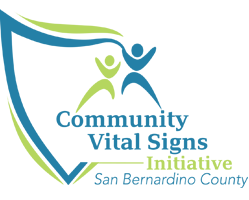Data and Reports
Data Requests
If you need a customized report and/or data, please submit a formal request using the button below.

Open Data & Performance

Community Vital Signs
This interactive portal tracks health data progress over time relating to the Community Transformation Plan’s four (4) priority areas: Health and Wellness, Education, Safety, and Economy.

HealthStat
HealthStat showcases our department’s open performance efforts. Click here to explore our performance, track our progress, and connect with us.
Please click the ribbons below to find links to valuable data sources along with our departmental plans and reports. Should you have any questions about this information, please contact us at DPHData@dph.sbcounty.gov.
AIDSVu – an interactive online mapping tool that visualizes the impact of the HIV epidemic on communities across the United States.
American Cancer Society: Facts and Figures – See the latest facts and figures on cancer occurrences, number of deaths, cases, and how long people survive after diagnosis.
American Community Survey (ACS) – premier source for detailed population and housing information about our nation.
American Fact Finder – Find popular facts (population, income, etc.) and frequently requested demographic data about your community.
AskCHIS – AskCHIS is an online health query system that allows you to quickly search for health statistics on your county, region, and state. AskCHIS draws upon the responses of more than 20,000 Californians interviewed each year by The California Health Interview Survey (CHIS) – the largest state health survey in the United States.
AtlasPlus – provides an interactive platform for accessing data collected by CDC’s National Center for HIV/AIDS, Viral Hepatitis, STD, and TB Prevention (NCHHSTP).
Behavioral Risk Factor Surveillance System (BRFSS) – The Behavioral Risk Factor Surveillance System (BRFSS) is the nation’s premier system of health-related telephone surveys that collect state data about U.S. residents regarding their health-related risk behaviors, chronic health conditions, and use of preventive services. BRFSS collects data in all 50 states as well as the District of Columbia and three U.S. territories.
California Department of Health Care Access and Information – The Behavioral Risk Factor Surveillance System (BRFSS) is the nation’s premier system of health-related telephone surveys that collect state data about U.S. residents regarding their health-related risk behaviors, chronic health conditions, and use of preventive services. BRFSS collects data in all 50 states as well as the District of Columbia and three U.S. territories.
Center for Disease Control and Prevention (CDC) – General public health information regarding many topics.
CDC Interactive Data Systems – Surveillance depends on the most accurate and latest data available. The page provides links to interactive database systems that contain continuously updated data and provide data reports by health topic.
CDC Sexually Transmitted Disease (STD) Data & Statistics – most recent statistical content for STDs.
CDC Wonder – CDC WONDER manages nearly 20 collections of public-use data for U.S. births, deaths, cancer diagnoses, tuberculosis cases, vaccinations, environmental exposures, and population estimates, among many other topics.
California Department of Public Health (CDPH) – General CA public health information regarding many topics.
CDPH California Breathing County Asthma Data Tool – presents detailed asthma information by county.
CDPH California Sexually Transmitted Disease (STD) Data – most recent available data and statistics for reportable sexually transmitted diseases (STDs) in California for chlamydia, gonorrhea, and syphilis.
CDPH California Opioid Dashboard – provides a data tool with enhanced data visualization and integration of statewide and geographically-specific non-fatal and fatal opioid-involved overdose and opioid prescription data. These dashboards will enable surveillance of several short and long-term goals currently targeted by California’s Prescription Drug Overdose Prevention program.
CDPH Community Burden of Disease and Cost Engine (CCB) – a tool to explore data on burden of disease in multiple levels of geographic granularity. The CCB currently displays over 15 years of California condition-specific mortality burden data, using a range of measures displayed at the statewide, county, community, and census tract levels, with interactive rankings, charts, maps and trend visualizations.
CDPH Shots for Schools: provides information on All Required Vaccines (ARV) rate, or the percentage of students in a school or child-care facility that received all required vaccines. Interactive data tools allow the user to search by school or by address to find information (current and historical) about the ARV for a specific school.
Census Bureau Interactive Visualization Gallery – repository of different analytical visualizations produced by the Census Bureau using Census data.
CHHS Open Data – The Open Data Portal initiative is meant to increase public access to one of the State’s most valuable assets – non-confidential health and human services data. The portal offers access to standardized data that can be easily retrieved, combined, downloaded, sorted, searched, analyzed, redistributed and re-used by individuals, business, researchers, journalists, developers, and government to process, trend, and innovate.
County Health Ranking and Roadmaps – The annual Rankings provide a revealing snapshot of how health is influenced by where we live, learn, work, and play.
Data USA – a portal that helps users understand and visualize the critical issues facing the United States in areas like jobs, skills, and education across industry and geography, as well as to inform decision making among executives, policymakers and citizens.
Healthcare Cost and Utilization Project (HCUP) Fast Stats – HCUP Fast Stats provides easy access to the latest HCUP-based statistics for health care information topics.
HealthData.Gov – a site is dedicated to making high value health data more accessible to entrepreneurs, researchers, and policy makers in the hopes of better health outcomes for all.
Healthy Places Index (HPI) – The California Healthy Places Index (HPI) is a powerful new tool, developed by the Public Health Alliance of Southern California, to assist you in exploring local factors that predict life expectancy and comparing community conditions across the state. The HPI provides overall scores and more detailed data on specific policy action areas that shape health, like housing, transportation, education and more. This website offers other resources everyone will find useful, including an interactive map, graphs, data tables, and policy guide with practical solutions for improving community conditions and health.
Kaiser Permanente Community Health Needs Assessment (CHNA) Data Portal – a web-based resource for communities as a way to support facilitating community health needs assessments.
Morbidity and Mortality Weekly Report – Weekly reports to the Center for Disease Control and Prevention (CDC) by State Departments.
NACo County Explorer – Explore your county through over 1000 indicators and nearly 100 data sets.
National Health and Nutrition Examination Survey (NHANES) – The National Health and Nutrition Examination Survey (NHANES) is a program of studies designed to assess the health and nutritional status of adults and children in the United States. The survey is unique in that it combines interviews and physical examinations.
Omnitrans GIS – provides most recently available geographic information system (GIS) data on transportation routes/lines and transportation stops.
California Department of Health Care Access and Information – visualizations and other data-based products from the information OSHPD manages.
State Health Facts – State Health Facts is a project of the Henry J. Kaiser Family Foundation and provides free, up-to-date, and easy-to-use health data for all 50 states, the District of Columbia, and the United States. In some cases, data are available for counties, territories, and other geographies. State Health Facts is comprised of more than 800 health indicators and provides users with the ability to map, rank, trend, and download data. Data come from a variety of public and private sources, including Kaiser Family Foundation reports, public websites, government surveys and reports, and private organizations.
UDS Mapper – A mapping and decision-support tool driven primarily from data within the Uniform Data System (UDS), previously not publicly accessible at the local level. Provides tools and data that can assist in evaluating the geographic reach, penetration, and growth of the Section 330-funded Health Center Program (HCP) and its relationship to other federally-linked health resources.
U.S. News Healthiest Communities Rankings (2019) – The U.S. News Healthiest Communities rankings measure crucial health-related components of society with the aim of empowering citizens, health care leaders and officials to make decisions about policies and practices that can improve health outcomes for all.
2020 Community Vital Signs Final Report – Serves as the community health assessment
Community Vital Signs Final Report – Serves as the community health assessment.
Community Transformation Plan (2015 – 2020) – Serves as the community health improvement plan.
Annual Report (Fiscal Year 2022 – 2023)
Annual Report (Fiscal Year 2018 – 2019)
Annual Report (Fiscal Year 2017 – 2018)
Annual Report (Fiscal Year 2016 – 2017)
Annual Report (Fiscal Year 2015 – 2016)
Communications Guide (2018)
Cultural Competency Assessment Report (2018)
Public Health Resource Guide (English and Spanish)
Public Health Workforce Interests and Needs Survey (PH WINS) (2017)
Quality Improvement Plan (2022-2023)
Stay Interview Guide (2018)
Strategic Plan (2015 – 2022) (Revised September 2021)
Workforce Development Assessment (2019)
NEW! Maternal, Child, Adolescent Health (MCAH) Publication and Data
Communicable Disease Section (CDS) Publications and Data
CDS Annual Morbidity Report (2018)
Analysis of Youth Development Survey Data (2016 – 2017) – The Youth Development Survey measures the experiences of Friday Night Live (FNL) and Club Live youth participants (ages 11 to 18 years) in the context of FNL Standards of Practice. Program outcomes can be found in the report.